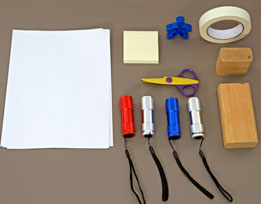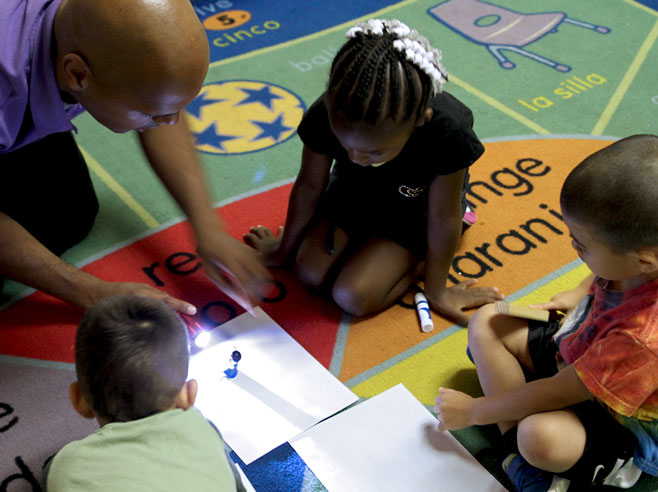Children explore how many ways they can move a flashlight to make the length and position of a shadow change. Then they work in pairs, shining two flashlights at an object.
Materials

- Flashlights (1 for each child)
- Small classroom objects such as: a block, a counting bear, a paper cup (1 for each child)
- Sheets of white paper (1 for each child to place the small object on)
Preparation
- Darken the area where you will meet with your small groups, so that shadows made with flashlights can be clearly seen.
Directions: Lesson 12
Guided Small Group
- Demonstrate how to move a flashlight up, down, over, and around a small object to see how many ways you can make the shadow move and change. Encourage children to describe how you are moving the flashlight (up, down, over, under, around; closer to/farther from (the object); side to side; making circles above, below) and how the shadow is changing and moving (getting longer/shorter, getting bigger/smaller, growing/shrinking; moving back and forth; moving in front of, behind, between, next to, over, under another object).
- Provide each child with a small object and a flashlight, and ask them to explore ways they can move the flashlight around their object (or blocker) to create shadows. Set different challenges such as:
- Make a shadow that is very long. Very short.
- Make a shadow that is very thin. Very wide.
- Make a shadow that is in front of another shadow. Between two other shadows.
- Make a shadow that wiggles back and forth.
- Make a shadow that circles round and round.
- Suggest that children work in pairs and shine both flashlights at one object. Discussion ideas:
- How many shadows can you see when you shine two flashlights on one object?
- Can you make one shadow grow short and one shadow grow long?
- Can you make one shadow hide inside the other shadow?
- Can you make one shadow wiggle and the other shadow stand still?
- Can you make one shadow move in a circle and the other shadow stand still?
- How many shadows do you think you would see if you shined three flashlights on one object? Try it out!
- Which shadow is made by which flashlight? How can you find out?


